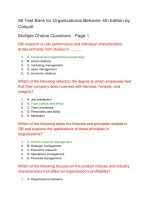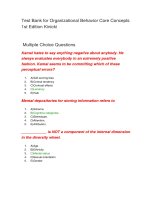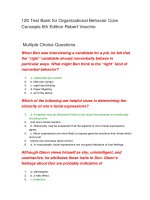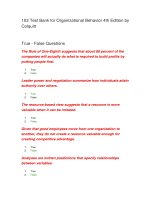Organizational behavior core concepts by kinicki chapter5
Bạn đang xem bản rút gọn của tài liệu. Xem và tải ngay bản đầy đủ của tài liệu tại đây (312.02 KB, 27 trang )
5
Organizational Behavior
core concepts
Motivation in Practice: How
to Bring Out the Best in
People
5-2
McGraw-Hill/Irwin
Organizational Behavior, Core Concepts
Copyright © 2008 by the McGraw-Hill Companies, Inc. All rights reserved.
Learning Objectives
• Explain how goals contribute to performance
management
• Describe how feedback can provide
information for improved performance
• Define types of rewards, and summarize their
relationship to performance
• Describe how the effects and consequences of
behaviors can influence future behaviors
5-3
Improving Individual Job Performance:
A Continuous Process
Situational
Factors
5-4
Performance
Improvement
Cycle
Desired
Outcomes
Figure 5-1
Motivation in Practice
• Performance management
– an organization-wide system for improving
performance by setting, monitoring, and
evaluating goals; providing feedback and
coaching; and rewarding employees on a
continuous basis
5-5
Types of Goals
• Performance outcome goal
– what an individual is trying to accomplish
• Learning goal
– defines the particular skills, knowledge, and
abilities the employee will acquire
5-6
Management by Objectives
• Management by objectives
– management system incorporating
participation in decision making, goal setting,
and feedback
5-7
Goal Setting Process
Step 1: Set goals
Step 2: Promote goal commitment
Step 3: Provide support
and feedback
5-8
Setting Goals
•
•
•
•
•
5-9
Specific
Measurable
Attainable
Results-oriented
Time-bound
Feedback
• Feedback
– objective information about performance
5-10
Functions of Feedback
• Instructional
– instructs employees by clarifying roles or
teaching new behavior
• Motivational
– serves or promises a reward
5-11
Recipients of Feedback
• Characteristics of the recipient
• Perception of feedback
• Cognitive evaluation of feedback
5-12
Characteristics of the recipient
• Employees with low self-esteem and low
self-efficacy tend not to actively seek
feedback
• Employees who are high in the need for
achievement respond more favorably to
feedback
5-13
Nontraditional Feedback
• Upward feedback
– employees evaluate their boss
• 360-degree feedback
– comparison of anonymous feedback from
one’s superior, subordinates, and peers with
self-perceptions
5-14
Organizational Reward Systems
• Extrinsic rewards
– financial, material, or social rewards from the
environment
• Intrinsic rewards
– self-granted, psychic rewards
5-15
A General Model of Organizational
Reward Systems
5-16
Figure 5-2
Building Blocks of Intrinsic Motivation
1.
2.
3.
4.
5-17
Leading for meaningfulness
Leading for choice
Leading for competence
Leading for progress
Organizational Reward Systems
• Pay for Performance
– monetary incentives tied to one’s results or
accomplishments
– Also known as incentive pay or variable pay
5-18
Organizational Reward Systems
• Team-based pay
– incentive compensation that rewards
individuals for teamwork, rewards teams for
collective results,
or both
5-19
Positive Reinforcement
• Law of effect
– behavior with favorable consequences is
repeated; behavior with unfavorable
consequences disappears
• Respondent behavior
– Skinner’s term for unlearned stimulus –
response reflexes
• Operant behavior
5-20
– Skinner’s term for learned consequenceshaped behavior
Contingent Consequences in
Operant Conditioning
Figure 5-3
5-21
Contingent Consequences
• Positive reinforcement
– making behavior occur more often by
contingently presenting something positive
• Negative reinforcement
– making behavior occur more often by
contingently withdrawing something negative
5-22
Contingent Consequences
• Punishment
– making behavior occur less often by
contingently presenting something negative
or withdrawing something positive
• Extinction
– making behavior occur less often by ignoring
or not reinforcing it
5-23
Schedules of Reinforcement
• Continuous reinforcement
– reinforcing every instance of a behavior
• Intermittent reinforcement
– reinforcing some but not all instances of a
behavior
5-24
Intermittent Reinforcement
1.
2.
3.
4.
5-25
Fixed ratio
Variable ratio
Fixed interval
Variable interval









